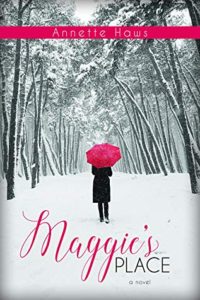 Title: Maggie’s Place
Title: Maggie’s Place
Author: Annette Haws
Covenant Communications, Nov. 1, 2019
Reviewed by Emily Debenham
There is a lot to enjoy in this contemporary novel set in urban Salt Lake City: the quirky elderly main character with a secret past, a teenage homeless girl looking for a way out, a little bit of romance tangled up in choosing to do the right thing, and a gaggle of seniors outwitting the bad guys and saving the day.
The author Annette Haws is also the writer of Waiting for the Light to Change, the 2008 Whitney Award Winner in General Fiction. Maggie’s Place will please the same audience, pulling from many story types to create a tale with broad appeal. Annette describes the novel best, writing, “It is a mystery, a romance, a morality tale, and a Christmas story, the story crosses genre lines, and hopefully, will appeal to a wide audience.”
I personally loved many parts of this book. The author is open about the fact that the novel is inspired by the life of her aunt who lived in the Eagle Gate apartments for the last decade of her life. My parents owned and lived in a condo in the same area for about five years and we had family gatherings there often. So, I have to admit the main draw of the book for me at first was nostalgia. I often took a similar walk as Maggie to Harmon’s down the street and the Library kitty-corner my parent’s condo. Reading the book transported me straight back to those days.
The author draws heavily on conflicts that plague modern-day northern, Utah–homelessness, affinity fraud, bullying, judgemental shunnings of those that don’t fit in. The membership status and spirituality of the characters aren’t the main concern of the story. However, you can’t erase the Mormoness of the novel. It lurks in the nooks and crannies and supports major plot points. It’s in the weekly schedules and basic functions of the community. Though it’s almost so quiet you wouldn’t notice it unless you knew what you were looking for.
I love the balance that the author was able to strike as she wove the many threads of this layered novel. Mormon literature struggles with the problem of polarity. It’s easy to find books that are “faithful” literature and books that are “critical” literature. It is hard to find anything neutral–a book that allows itself to be Mormon without taking on either label is a rare gem indeed. This brilliant balancing act also applies to the way the novel balances literary tastes with genre expectations. The beginning of the novel bends more literary and can feel a little slow. The end of the novel bends itself to genre expectations and has a satisfying, albeit formulaic ending. I really appreciated this lovely blend. It’s fun to read a novel that has a little bit of everything for someone because it means you can share it with more people. I highly encourage you to take a chance on this quirky but ultimately satisfying novel.
